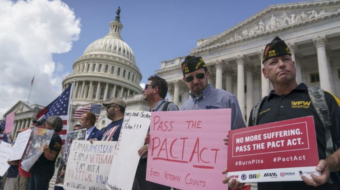The labor movement, determined to be heard as Congress and President Obama hammer out changes in the U.S. healthcare system, is insisting that any new plan include the four features of cost controls, a public option to compete with private insurers, a ban on taxation of employer-based plans, and a choice of doctors and hospitals.
Although unions were not included in the “roundtables” held by key congressional committees last month, they are determined to be represented at formal hearings in June and they plan to lobby lawmakers on an almost round-the-clock basis. The labor movement is also organizing grass-roots demonstrations in support of its four point program.
Almost all the unions that have endorsed single-payer government-run health care coverage are joining in the effort, not because they have changed their position but because they realize a new national approach to health care will emerge, probably by the fall, and they want to insure that the approach that does emerge is the most progressive one possible.
The labor movement sees the skyrocketing cost of healthcare as an impediment to any type of economic recovery. Health care costs raced upwards by 97 percent in the last ten years, leaving inflation and wage hikes in the dust. The costs have been a burden to unions, have forced workers to trade wage hikes for keeping their insurance, and have made companies less than competitive on the world market.
The unions also note that in exchange for all these costs, Americans are getting health care that is inadequate when compared to what is available in many countries around the world.
“The economy cannot afford not to reform health care. We need to mobilize an army across the country to change the health care system by the end of this year and we need nurses at the head of that army.” The words were those of President Obama’s Health and Human Services Secretary Kathleen Sebelius as she addressed a legislative conference in Washington May 6. The conference of nurses was called by the American Federation of State County and Municipal Employees.
“When you talk to members of Congress, talk to them as if they care about the issue, but do not assume they know about it,” Sebelius warned.
The AFSCME nurses’ gathering was the first of several major union legislative conferences in May and June. Others scheduled include one for the entire AFSCME, one for all the unions representing the Building Trades, one for the Newspaper Guild and another for the Communications Workers of America.
At the nurses’ convention Sebelius listed Obama’s objectives for the health care revision effort. She did not include a “public option” for those who could not get coverage otherwise but did include the other three points the labor movement is insisting upon.
When he was campaigning for the presidency last year Obama included the public option as one of the planks in his proposals for health care reform.
Sebelius nevertheless joined with AFSCME Secretary-Treasurer Bill Lucy in urging the nurses to lobby for all of labor’s goals, including the public option.
Gerald Shea, a health care specialist for the AFL-CIO, told the House Ways and Means Committee on April 29 that “Congress should create a public insurance alternative to the private insurers, their high profits, high co-pays, deductibles and spending on overhead. Creating a public health insurance plan to compete with private health insurance plans will lead to substantial savings throughout our health care system as a result of that competition.”









